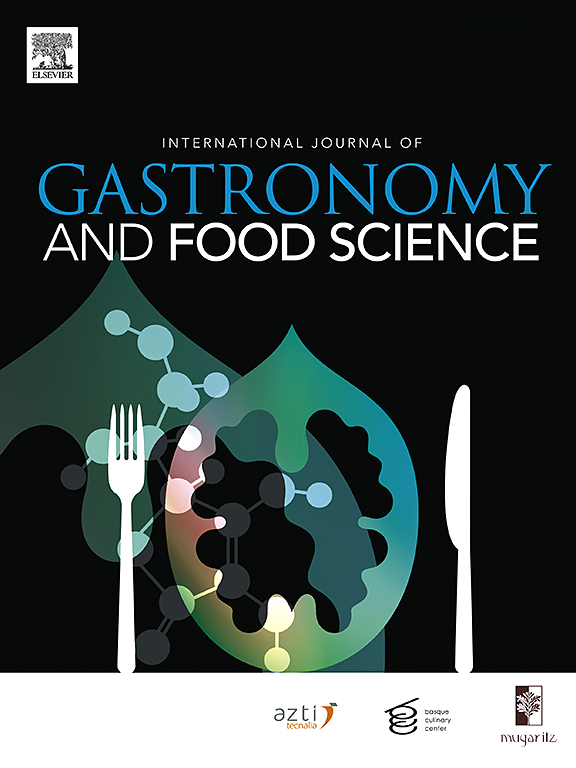克氏原螯虾经热烫预处理及油炸后脂质氧化及风味特性探讨
IF 3.2
2区 农林科学
Q2 FOOD SCIENCE & TECHNOLOGY
International Journal of Gastronomy and Food Science
Pub Date : 2025-01-02
DOI:10.1016/j.ijgfs.2025.101100
引用次数: 0
摘要
本实验研究了热水烫烫、油炸和烫烫加油炸对小龙虾脂质氧化和风味特性的影响。结果表明,煎前焯水处理的小龙虾脂肪含量较高,但酸值、ρ-茴香胺、共轭烯烃、硫代巴比妥酸值等指标均低于煎后处理的小龙虾。油炸前的焯水会显著增加游离氨基酸,尤其是鲜味氨基酸。此外,经过焯水和油炸的那一组的棕榈酸和油酸含量显著增加。在挥发性化合物方面,BF组在14种关键挥发性化合物中表现出显著变化,尤其是吡嗪类化合物的种类和数量。相关分析表明,脂肪酸和游离氨基酸的变化影响风味物质的组成。这些发现表明,煎炸前焯水可以减少脂质氧化,增加挥发性化合物的产生,改善风味,从而为小龙虾加工和促进健康饮食提供见解。本文章由计算机程序翻译,如有差异,请以英文原文为准。
Exploration into lipid oxidation and flavour characteristics of crayfish (Procambarus clarkia) after hot water blanching pretreatment and deep frying
In this research, we studied the effects of hot water blanching (HB), deep frying (DF), and blanching combined with deep frying (BF) on the lipid oxidation and flavor characteristics of crayfish. The results indicated that crayfish which were subjected to blanching before frying had higher fat content but lower levels of certain indicators such as acid value, ρ-anisidine, conjugated alkenes, and thiobarbituric acid value compared to those only fried. Blanching prior to frying resulted in a significant increase in free amino acids, particularly umami amino acids. Furthermore, the group that underwent blanching combined with deep frying exhibited significant increases in palmitic and oleic. Regarding volatile compounds, the BF group showed significant changes in 14 key volatile compounds, especially in the type and amount of pyrazines. Correlation analysis indicated that changes in fatty acids and free amino acids influenced the composition of flavor substances. These findings suggest that blanching before frying could minimize lipid oxidation, enhance volatile compound production, and improve flavor profiles, thereby providing insights for crayfish processing and promoting healthy eating practices.
求助全文
通过发布文献求助,成功后即可免费获取论文全文。
去求助
来源期刊

International Journal of Gastronomy and Food Science
Social Sciences-Cultural Studies
CiteScore
5.30
自引率
10.50%
发文量
170
审稿时长
45 days
期刊介绍:
International Journal of Gastronomy and Food Science is a peer-reviewed journal that explicitly focuses on the interface of food science and gastronomy. Articles focusing only on food science will not be considered. This journal equally encourages both scientists and chefs to publish original scientific papers, review articles and original culinary works. We seek articles with clear evidence of this interaction. From a scientific perspective, this publication aims to become the home for research from the whole community of food science and gastronomy.
IJGFS explores all aspects related to the growing field of the interaction of gastronomy and food science, in areas such as food chemistry, food technology and culinary techniques, food microbiology, genetics, sensory science, neuroscience, psychology, culinary concepts, culinary trends, and gastronomic experience (all the elements that contribute to the appreciation and enjoyment of the meal. Also relevant is research on science-based educational programs in gastronomy, anthropology, gastronomic history and food sociology. All these areas of knowledge are crucial to gastronomy, as they contribute to a better understanding of this broad term and its practical implications for science and society.
 求助内容:
求助内容: 应助结果提醒方式:
应助结果提醒方式:


